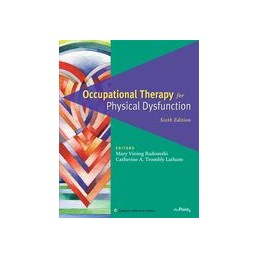- Reduced price

Order to parcel locker

easy pay


 Delivery policy
Delivery policy
Choose Paczkomat Inpost, Orlen Paczka, DHL, DPD or Poczta Polska. Click for more details
 Security policy
Security policy
Pay with a quick bank transfer, payment card or cash on delivery. Click for more details
 Return policy
Return policy
If you are a consumer, you can return the goods within 14 days. Click for more details
The definitive work on occupational therapy for physical dysfunction returns in its Sixth Edition, with reputable co-editors and clinical, academic, and consumer contributors. This text provides a current and well-rounded view of the field- from theoretical rationale to evaluation, treatment, and follow-up. Through the Occupational Functioning Model (OFM), the Sixth Edition continues to emphasize the conceptual foundation and scientific basis for practice, including evidence to support the selection of appropriate assessments and interventions.
NEW TO THIS EDITION::
Data sheet
SECTION I:: OCCUPATIONAL FUNCTION:: DEFINITION, PROCESS, AND HISTORY
Chapter 1:: Conceptual Foundations for Practice
Chapter 2:: Historical and Social Contexts for Practice
Chapter 3:: Planning, Guiding, and Documenting Practice
SECTION II:: ASSESSMENT OF OCCUPATIONAL FUNCTION
Chapter 4:: Assessing Roles and Competence
Chapter 5:: Assessing Abilities and Capacities:: Range of Motion, Strength, and Endurance
Chapter 6:: Assessing Abilities and Capacities:: Motor Behavior
Chapter 7:: Assessing Abilities and Capacities:: Sensation
Chapter 8:: Assessing Abilities and Capacities:: Vision, Visual Perception, and Praxis
Chapter 9:: Assessing Abilities and Capacities:: Cognition
Chapter 10:: Assessing Context:: Personal, Social, and Cultural
Chapter 11:: Assessing Context:: Home, Community, and Workplace Access
SECTION III:: THERAPEUTIC MECHANISMS
Chapter 12:: Occupation:: Philosophy and Concepts
Chapter 13:: Occupation as Therapy:: Analysis, Selection, Gradation, Adaptation
Chapter 14:: Learning
Chapter 15:: Therapeutic Rapport
SECTION IV:: THERAPEUTIC TECHNOLOGIES
Chapter 16:: Upper Extremity Orthoses
Chapter 17:: Construction of Hand Splints
Chapter 18:: Wheelchair Selection
Chapter 19:: High-Technology Adaptations to Compensate for Disability
Chapter 20:: Physical Agent Modalities
SECTION V:: TREATMENT OF OCCUPATIONAL FUNCTION
Chapter 21:: Optimizing Abilities and Capacities:: Range of Motion, Strength, and Endurance
Chapter 22:: Optimizing Motor Behavior Using the Occupational Therapy Task Oriented Approach
Chapter 23:: Optimizing Motor Skills Using Task-Related Training
Chapter 24:: Optimizing Motor Behavior Using the Bobath Approach
Chapter 25:: Optimizing Motor Behavior Using the Brunnstrom Movement Therapy Approach
Chapter 26:: Managing Deficit of First-Level Motor Control Capacities Using Rood and Proprioceptive Neuromuscular Facilitation Techniques
Chapter 27:: Optimizing Sensory Abilities and Capacities
Chapter 28:: Optimizing Vision, Visual Perception, and Praxis Abilities
Chapter 29:: Optimizing Cognitive Abilities
Chapter 30:: Restoring the Role of Independent Person
Chapter 31:: Restoring Mobility
Chapter 32:: Restoring Competence for Homemaker and Parent Roles
Chapter 33:: Restoring Competence for the Worker Role
Chapter 34:: Restoring Competence in Leisure Pursuits
Chapter 35:: Optimizing Personal and Social Adaptation
Chapter 36:: Optimizing Access to Home, Community, and Work Environments
Chapter 37:: Preventing Occupational Dysfunction Secondary to Aging
SECTION VI:: TREATMENT TO PROMOTE OCCUPATIONAL FUNCTION FOR SELECTED DIAGNOSTIC CATEGORIES
Chapter 38:: Stroke
Chapter 39:: Traumatic Brain Injury
Chapter 40:: Neurodegenerative Diseases
Chapter 41:: Orthopaedic Conditions
Chapter 42:: Hand Impairments
Chapter 43:: Spinal Cord Injury
Chapter 44:: Rheumatoid Arthritis and Osteoarthritis
Chapter 45:: Burn Injuries
Chapter 46:: Amputations and Prosthetics
Chapter 47:: Cardiac and Pulmonary Diseases
Chapter 48:: Dysphagia
Chapter 49:: Human Immunodeficiency Virus
Chapter 50:: Oncology
